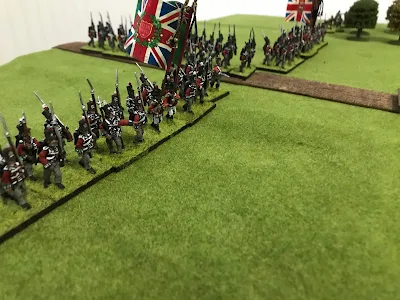The game starts with the British entering the table in the southeast corner. American rifle armed troops are in the fields to their flank. The main American army is in position on the other side of the stream. The all important wagon train is slowly moving up the road to make their escape. It moves at a speed of four inches per turn; so its slow! The Americans must buy time for the wagons to escape, and then withdraw off the table. The British must capture the bridge and the town and the wagons if possible .
Turns 1 & 2:
The British enter the table from around the road. The light infantry are pushed toward the stream while the Jagers move to their right towards the American Rifle men. The Grenadiers boldly push forward to cross the bridge.
The American rifles fire and fall back. At long range neither side is scoring any hits.
The Hessian Brigade moves up to support the Jagers and to look for a crossing upstream. Grenadier Regiment Rall in front followed by Fusilier regiment Knyphausen. In addition the Royal Artillery moves up to support the British advance. The 7th and 63rd Regiments of foot are just entering the table.
The Americans take positions behind fences and walls. Still at very long range a few militia men fire at the close pack column of British. The Continental line holds their fire waiting for the enemy to close into close range.
Meanwhile the wagons slowly move up the road.
Turn 3 & 4:
The Grenadiers charge across the bridge and quickly form into line. Although the Militia battalion gets a shot at them they pass morale and next turn close into close combat. The light infantry moves to cover the Grenadier flank and exchanges musket fire with the 9th Continentals.
The next turn the Grenadiers charge the militia. Its an uneven fight and the militia are defeated and lose their colors. They rout back and the Grenadier battalion takes the stone wall. The lights continue to screen their flank and the 7th and 63rd move up to cross the stream.
The 9th Continental falls back and the 11th Continental and New York (Hamilton's) Artillery move up in support.
The American rifles continue to exchange fire with the jagers as they fall back from cover to cover. They two units leapfrog each other to give a continuous fire. Remember that rifles have superior range but take longer to reload (they fire every other turn.
The American rifles are running out of terrain to fall back on. All the rifle armed units are suffering heavy casualties by this time. One American unit crossed the stream and took up position to cover their brothers. The Hessian battalions move forward. The jagers fall back after suffering over 50% casualties.
And still the wagons make their way up the road trying to escape!
Turns 5 & 6:
With the jager company shot up and in retreat, the Grenadier Regiment Rall took up the pursuit of the retreating rifle units. As the Pennsylvania rifle unit arrived at the ford the regiment Rall fired a tremendous volley which decimated the retreating rifles.
Both the British, now across the stream and the Americans firmed up to prepare for the next attacks.
End of part 1



















































